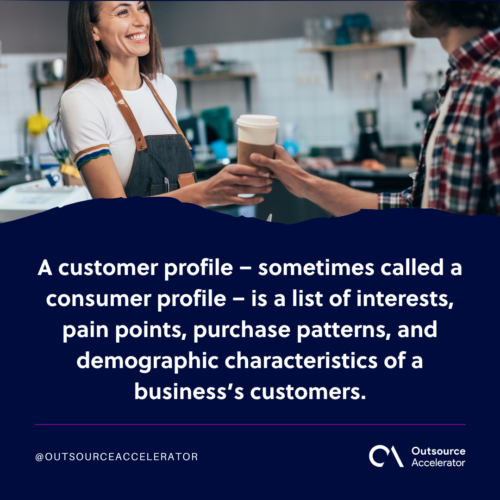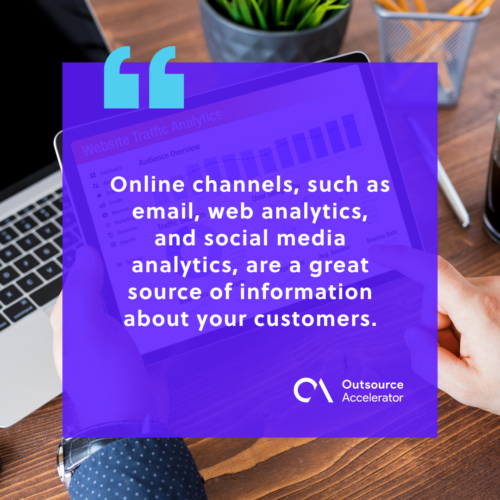How creating a customer profile can help your marketing campaigns

Creating an effective marketing campaign can be a tricky business for marketers.
There are numerous factors they must consider, such as objectives, the target audience, and the platform they’ll use.
Among these factors, understanding their target audience is perhaps the most important. After all, it’s these audiences they’ll be targeting with their campaign.
There are techniques marketers can use to understand their target audience better.
One of these techniques is creating a customer profile.
What is a customer profile?
A customer profile – sometimes called a consumer profile – is a list of interests, pain points, purchase patterns, and demographic characteristics of a business’s customers.
These details can be listed in a document or in platforms like customer relationship management (CRM) software.
A good customer profile contains more than just basic information, such as names and addresses.
Ideally, it should also include job titles, salary or salary range, sex, and educational attainment.

The data marketers use in creating a customer profile can be categorized into different groups:
Demographic data
These are the basic types of data often used in creating a customer profile. It includes some of the information already mentioned earlier, such as:
- Age
- Sex
- Job title
- Education
- Family status
Psychographic data
Data in this category include the justifications and reasons behind consumers’ purchasing decisions. [1]
It includes:
- Lifestyle
- Goals
- Motivations
- Pain points
- Habits
- Values
- Interests
Behavioral data
Behavioral data involves details on how a consumer manifested their psychographic data.[2] These data are shown by their:
- Engagement
- Readiness to buy
- Purchase history
- Account age
Geographic data
The physical location of consumers, such as city, province, region, and country.
These types of information are helpful to marketers when making campaigns targeted at consumers living within a particular area.
B2B vs B2C customer profile
A customer profile doesn’t only apply to individual consumers; it can also include companies.
Naturally, a customer profile made for individuals will be different from one made for a business entity.
When creating a profile for a company, marketers must look at:
- Revenue
- Company size
- Industry
- Location
- Employee count
- Annual turnover rate
- Target audience
How to create a customer profile
The effectiveness of a customer profile is reliant on how well-made it is. Thus, it’s important to ensure that marketers take a systematic approach when creating one.
Below are steps marketers can follow to ensure that their customer profiles will meet their needs.
1. Identify your best customers
The first step to creating a customer profile is researching the people that patronize your products or services.
Look at your customer database and find the top five to ten customers who are getting the most out of your business’s products or services.
If your business is new and you lack a sufficient number of customers to work with, listing the types of people who will benefit from your products or services work.
For example, if you’re selling ergonomic chairs, you can add computer users to your list of top customers.
2. List their notable traits
Once you’re done with your list, proceed to write their notable attributes.
These attributes may pertain to demographics, psychographics, geographic segmentation, firmographics (for B2B profiles), and socioeconomics.
3. Survey them
As you list down your best customers’ notable attributes, you may notice that you know more about some of them than others.
Conducting surveys can help fill up your knowledge gap in this area.
There are free tools like Google Forms that you can use to conduct these surveys.
Naturally, your survey questions should aim to fill in the missing knowledge in your list of traits (e.g., questions about demographics, psychographics, or socioeconomics).
4. Use data from your online channels
Online channels, such as email, web analytics, and social media analytics, are a great source of information about your customers.
Each channel can provide different insights regarding your customers’ habits, interests, and pain points.
These data, together with the list of your customers’ notable traits, can provide a more detailed outlook on your customer profile.

5. Fill in the customer profile
Now that you’ve covered your customers’ notable traits and understand why they patronize your business, you need to put these into a single document.
A recommended way of organizing these details is to list them as follows:
- Give the “customer” a name
- Put a face on the customer
- Add the customer’s demographic information
- Add the customer’s psychographic and socioeconomic traits
- Add a quote from the customer
- Add the customer’s goals, pain points, and motivations
- Add the customer’s preferred communication channel
When creating the customer profile, remember that you can make it as detailed as you want. However, keeping it simple is recommended to avoid getting paralyzed by information overload.
How creating a customer profile helps
Having a customer profile gives marketers plenty of benefits.
These advantages include:
Improves targeted marketing
It’s easier for marketers to create targeted ads when they already have access to the profiles of their intended audience.
For example, say that you have a bike shop, and your target audience is millennials who enjoy long-distance cycling.
You can then add bicycle accessories and other peripheries on sale in your next newsletter.
Improves customer experience
Access to customer profiles makes it easier to make your customers’ experience more personalized.
It also allows customer service providers to give better support to customers, as they already have an idea of the customer’s pain points.
Improves sales rate
Better targeted marketing means you get better-quality leads.
These leads are more likely to be converted into customers and therefore increase the number of deals you can close.
Reduce customer churn
Higher-quality leads produce more invested customers who actually need or rely on your products or services. This can help your business from having “come-and-go” customers.
Tools marketers can use in creating a customer profile
There are various tools available online that marketers can use in creating a strong customer profile.
These can include:
- Data collection tools (e.g., lead capture forms, surveys)
- Communication platforms (e.g., emails, social media)
- Web analytics (e.g., Google analytics, customer accounts)
- Core business tools (e.g., eCommerce platforms, billing systems, CX platforms)
References
[1] customers’ purchasing decisions. Limayem, M. et al. (2000). “What makes consumers buy from the internet? A longitudinal study of online shopping.” Institute of Electrical and Electronics Engineers, 30(4), pp. 421-432. DOI: 10.1109/3468.852436
[2] psychographic data. Lin, C. (2002). “Segmenting customer brand preference: demographic or psychographic”. Journal of Product & Brand Management, 11(4), pp. 249-268. https://doi.org/10.1108/10610420210435443







 Independent
Independent




